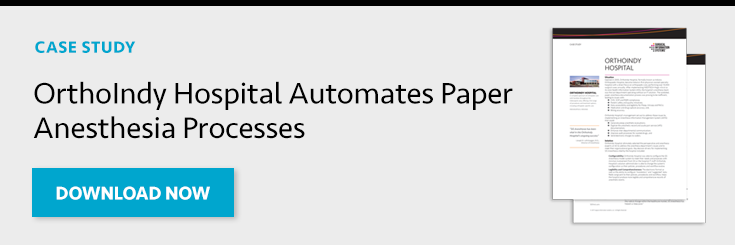 Incomplete anesthesia clinical documentation puts a facility and its anesthesia providers at risk and may violate regulatory requirements.
Incomplete anesthesia clinical documentation puts a facility and its anesthesia providers at risk and may violate regulatory requirements.
Anesthesia services are governed by regulators, including the Centers for Medicare & Medicaid Services (CMS), American Society of Anesthesiologists, and The Joint Commission.
All have similar and sometimes overlapping requirements. It's critical to maintain compliance with these requirements when completing clinical documentation.
There are also implications regarding liability if an adverse event occurs. Comprehensive, legible documentation can support determining what happened to cause an event and what steps were taken to recover. Almost every anesthesiologist and certified registered nurse anesthetist will, at some point in their career, experience providing care to a patient who suffers an adverse event. If this incident leads to a lawsuit, the anesthesia record will likely become part of the legal proceeding. A complete, accurate anesthesia record can help absolve the provider if it shows the provider followed "accepted" policies and procedures.
Here are four components of anesthesia documentation that are often found missing in incomplete records and how technology can help prevent these omissions.
1. Automated Vitals
The anesthesia record should include regular notations concerning patient vital sign figures, such as blood pressure, heart rate, and oxygen percent. Documentation of these values should occur throughout a procedure at specific time intervals based on phase of care. While entering this information is typically routine, anesthesia providers may miss one or more entries if they become busy with patient care or handling an adverse event.
The use of a system that automates the recording of vital signs can help prevent gaps in this documentation. Anesthesia software system can be configured to collect this information at different intervals. Once the physiological data begins recording, it continues without any input required from providers. There's no need to write or type information every few minutes, which saves time, helps eliminate human documentation errors, and enables the anesthesia provider to focus on the patient instead of worrying about the documentation.
If an adverse event occurs, the system continues recording the vital signs as displayed on the physiologic monitor and ventilator. Irregularities are documented while providers are free to shift their attention toward helping address the problem without concerns of missing details.
2. Accurate Details Regarding Adverse Events
As discussed in the previous section, an anesthesia provider's attention during an adverse event will be on the patient and helping perform the tasks necessary to help stabilize the situation. Providers are then expected to document the steps they took during the event and note approximately when these steps occurred. Trying to accurately do so can prove difficult if the timing of changes in a patient's vitals are unknown.
If you're using an automated system to capture vitals, entering accurate information becomes much easier. Let's say there's a significant drop in blood pressure. An anesthesia provider might give the patient fluids and a medication to boost pressure, with vitals hopefully returning to normal.
When reviewing the vital signs data captured by the system, the provider will see when the blood pressure dropped. If this event occurred at 10:45 and was corrected by 11:00, the provider can document the different steps taken during this block of time and when they were taken rather than trying to approximate when the problem occurred, what actions were taken, and how the problem was resolved.
3. Data for Quality Reporting
Anesthesia providers need to access quality indicators and outcomes data in their clinical documentation for quality reporting and they want the process to be as easy as possible. This information is typically not included in the patient's paper medical record. Rather, it is often noted on separate paperwork in the operating room, which is not efficient.
The right technology can take a facility’s and/or anesthesia group's quality indicators and incorporate those into the electronic documentation, providing an easier means of noting indicators and outcomes while keeping them separate from the patient's chart. Note: Quality indicator data should be held separate from a patient's clinical chart to encourage staff to report events.
4. CMS Documentation Requirements
Anesthesia providers are required to meet CMS requirements to receive Medicare and Medicaid reimbursement. Anesthesia providers need to meet CMS requirements to receive Medicare and Medicaid reimbursement.
CMS requires seven documentation steps for compliance and reimbursement. One of these steps is a preanesthetic examination and evaluation of the patient to document safety risk factors, such as sleep apnea, difficult airways, and history of nausea and vomiting with surgery. If providers predict a problem associated with these or other risk factors, they are expected to take steps to mitigate the risk.
Another step takes place when a patient awakens in PACU. Providers should be able to document that patient returned to baseline: vital signs stable, pain under control, patient able to participate in the evaluation, and no postoperative nausea and vomiting (or it's being addressed). This is the final required CMS documentation step (i.e., providing post-anesthesia care, including a post-operative evaluation to ensure that the patient has fully recovered from anesthesia).
The use of an electronic solution can help anesthesia providers consistently document all the steps, reducing (and possibly eliminating) the opportunity for a missed step or missed documentation of the step.
Note: Some solutions are designed to allow easy changes to documentation requirements, such as when CMS introduces a new step or updates an existing step. While changes are infrequent, and providers usually have ample notice about these revisions, quality indicators undergo more regular changes. A solution that is easy to configure by the facility can help reduce the likelihood of anesthesia providers falling out of compliance with new documentation rules.
Commit to Comprehensive Anesthesia Documentation
We noted at the beginning of this column about the importance of comprehensive anesthesia documentation for compliance and liability. But one could argue that its most critical value is helping ensure patient safety and high-quality care.
Documentation that is easily completed allows anesthesia providers to spend more time focusing on patient safety and quality, while documentation that can be effectively reviewed and analyzed may provide valuable insight into opportunities for improvement in anesthesia delivery and the overall surgical care experience. Those reasons alone should serve as the impetus for ensuring your facility has the technology and processes in place to give anesthesia providers a simple, efficient means of completing their documentation.




























